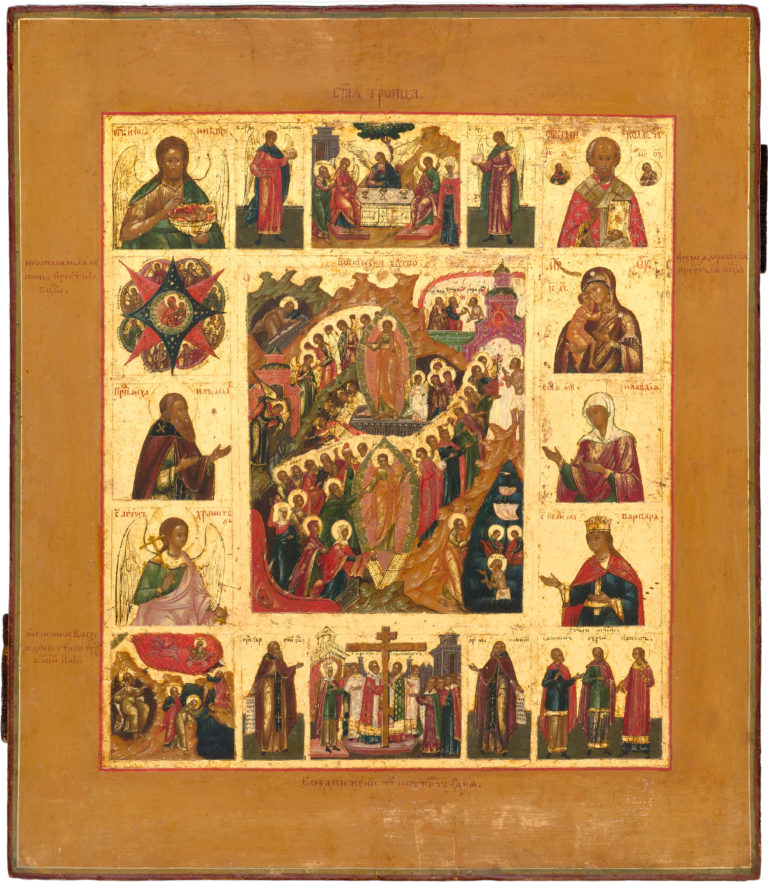The Resurrection—the Descent into Hell, with Selected Saints and Church Feasts
Antique Russian icon. Second quarter of the 19th century. Palekh.
Size: 36 х 31 х 2.8 cm
Wood (one whole panel), two incut profiled support boards, smooth incut centerpiece, underlying layer of canvas not visible, gesso, tempera, gold.
The author’s paintwork is in an overall good state. Slight chafing of the paint layer presents.
Contact us

The Resurrection—the Descent into Hell, with Selected Saints and Church Feasts
Diagram of the border scenes:
- John the Baptist – the Angel of the Desert;
- The Archangel Gabriel;
- The Old Testament Trinity;
- The Archangel Michael;
- Saint Nicholas the Archbishop of Myra;
- The Mother of God – The Unburnt Bush;
- The Feodorov Icon of the Mother of God;
- Saint Michael Malein;
- Saint Claudia the Martyr;
- The Guardian Angel;
- Saint Barbara the Martyr;
- The Fiery Ascent of the Prophet Elias;
- Saint Sergius of Radonezh;
- The Elevation of the Holy Cross;
- Saint Macarius of Unzha and Zheltovodsk;
- The Martyrs Samon, Gurius, and Aviv.
Eastern Orthodox Church icons with complex iconographic schemes that include the main Church Feasts, Old Testament Prophets, Holy Fathers, Russian Church Hierarchs, Venerated Icons of the Mother of God, and a large number of selected saints reflect the Imperial-era principle, according to which a privately commissioned religious icon is supposed to reflect – in one form or another – the iconostasis principle. The Resurrection belongs to the more complex variation that combines the scenes of the Rising from the Tomb with the Harrowing of Hades (placed one over another along a vertical axis), with added images of angelic powers breaking the gates of Hell and chaining Satan, as well as the depiction of the Procession of the Pious to the Kingdom of Heaven. In the upper left corner of the antique icon centerpiece, we see Saint Peter the Empty Tomb; in the lower right – the Revelation of Christ to the Apostles at the Sea of Galilee.
The complex iconographic program of the given hand-painted Orthodox icon reveals several themes that probably have a direct relation to the personal life of the commissioner. The selected scenes are amongst the most popular Russian icon paintings in Palekh: the center of the topmost row is traditionally occupied by the Old Testament Trinity, while the lower row bears the depictions of the Fiery Ascent of the Prophet Elias and the Elevation of the Holy Cross – two of Palekh’s churches were consecrated in honor of these feasts. The border scenes of the religious icon are most likely occupied by the patronal saints of the commissioner (Saint Michael Malein, the Martyrs Claudia, and Barbara), and the image of the Guardian Angel, who, according to Church tradition, is assigned to a person at birth and faithfully accompanies him or her until death, when he brings the soul to Heaven.
We also see a series of venerated Marian icons and holy icons of saints, which were seen as helpers in various trials and tribulations. In the upper row, we find the St. Nicholas icon – the depiction of Saint Nicholas of Myra, one of the most venerated saints of the Christian world. In folk tradition, the springtime feast of this saint (celebrated on May 9th) was closely tied to the start of the agricultural year, the rebirth of nature, and the grazing season. Folk tales also juxtapose the “merciful” Saint Nicholas with the “formidable” Prophet Elias (border scene 12), who was seen as lord of thunder and rain, and a saint, whose terrible wrath would fall on the sinful. The figure of Saint John the Forerunner reminds us of the mystery of Baptism. At the same time, some of the saints depicted in this beautiful antique Russian icon may also reflect the theme of death. John the Baptist proclaimed “baptism in repentance for the forgiveness of sins” (Mark 1:4; Luke 3:3), saint Nicholas and the Archangel Michael (who stand side by side) were seen as the guides of souls into Heaven, while Saint Barbara was venerated as the one who protected the faithful against sudden death without repentance. The Russian Orthodox icon of the Mother of God – the Unburnt Bush was considered the protector from fire, while the prayer before the Feodorov Icon of the Mother of God was supposed to bring ease at childbirth (that is why this religious icon is depicted directly over the images of the women patron saints). The saints Gurius, Samon, and Aviv, portrayed in the lower row of the given hand-painted icon, were venerated as the patrons of marriage and peaceful life between the husband and wife.